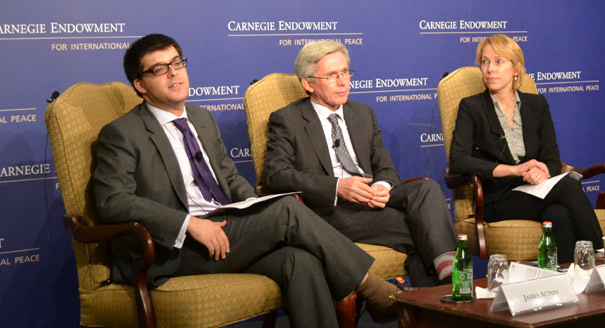Registration
You will receive an email confirming your registration.
IMGXYZ4075IMGZYXThe discussion about future nuclear reductions remains focused on the long-standing bilateral U.S.-Russia framework. However, multilateral nuclear restraint also deserves attention. In his recent book, Less Is Better: Nuclear Restraint at Low Numbers, funded by the Nuclear Threat Initiative, Malcolm Chalmers explores steps that all nuclear-armed states should take to enable progress to low numbers. The Carnegie Nuclear Policy Program and the Nuclear Threat Initiative hosted a discussion of the book’s key findings. Joan Rohlfing, president and chief operating officer of the Nuclear Threat Initiative, delivered opening remarks and Carnegie’s James Acton moderated.
Promising Recommendations
Rohlfing praised Less is Better for outlining potential pathways to a safer and more secure world with fewer nuclear weapons.
- Bilateral Disarmament: Rohlfing noted that widespread discussion of how states can achieve and maintain stability in a world with fewer nuclear weapons can reinvigorate stalled progress toward substantial nuclear reductions by the United States and Russia.
- Multilateral Disarmament: Rohlfing also noted the importance of considering a new multilateral approach. She emphasized that while the United States and Russia will remain leaders in nuclear disarmament, all nuclear states must engage in nuclear restraint.
Lessons Learned
Chalmers suggested that states with smaller nuclear arsenals might provide lessons in how achieve stability at low numbers.
Less is (Usually) Better
- The Prudent Choice: Reductions would reduce the risk of nuclear war by lessening the potential scale of the destruction, Chalmers argued. He recommended that reductions emphasize strategic weapons, such as intercontinental ballistic missiles, instead of tactical and non-deployed warheads, and noted that New START provides a good model for this approach.
- Number Illusions: Chalmers argued that nuclear superiority does not enhance deterrence. The quest for superiority not only inflates nuclear arsenals unnecessarily, it can actually undermine political objectives by lulling a state into a false sense of security because its threats lack credibility, Chalmers claimed.
- Drawing a Line: Nonetheless, Chalmers noted, there is a limit beyond which further nuclear reductions may threaten strategic nuclear stability. He suggested that states will be more willing to make deep cuts in their arsenals, especially in the case of Russia and the United States, if they keep the option to reconstitute their arsenals if new threats emerge.
Next Steps in Arms Reduction
- United States and Russia: The United States and Russia have already significantly reduced the size of their arsenals of both strategic and sub-strategic weapons. Chalmers suggests that economic factors may continue to push this process forward for the next decade. Thus, in one sense, progressing to nuclear restraint at low numbers is a continuation of existing trends.
- Multilateral Restraint at Low Numbers: Chalmers argued that U.S.-Russian arms control is not easily transferrable to the multilateral context. He suggested that nuclear restraint at low numbers will require a more flexible and less legalistic approach than traditional bilateral models of nuclear reduction.
How to Accelerate Reductions
- Encourage Bilateral Reductions: The greater the reductions in U.S. and Russian nuclear arsenals, the greater the pressure will be on other nuclear arms states to also reduce their own stockpiles.
- Increase Multilateral Transparency: Chalmers suggested that appropriate transparency by China, India, the United Kingdom, Pakistan, and France would constitute a step in the right direction.
- Avoid Unsettling Bilateral Relations: Dangerous Cold War-style deterrence relationships promote nuclear escalation. Chalmers expressed concern about the potential for an even more dangerous bilateral relationship to develop between India and Pakistan, particularly as the range of these countries’ ballistic missiles increases.
- Strengthening the Nonproliferation Regime: Chalmers noted that it is very unlikely that India and Pakistan would ever join the Nuclear Non-Proliferation Treaty. But he suggested that the international community could encourage India and Pakistan to assume some of the associated responsibilities already taken up by the other nuclear weapons states, such as the non-transfer of nuclear technology.
Multiple Ways Forward
Chalmers noted that Less is Better is not a blueprint for nuclear reductions, but rather is intended to stimulate thought among the policy community about how to incentivize nuclear restraint. He stressed that deep nuclear reductions do not require the radical transformation of international politics necessary to achieve a world without nuclear weapons. Chalmers concluded that nuclear restraint can bestow significant benefits on the strategic environment. Most importantly, it has the serious potential to contribute to confidence building among the nuclear-armed states.
